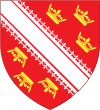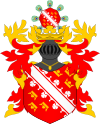Route Romane d'Alsace




The Route Romane d'Alsace (Romanesque Road of Alsace) is a tourist itinerary designed by the Association Voix et Route Romane[1] to link both the well-known and the more secret examples of Romanesque architecture of Alsace,[2] in an itinerary of 19 stages, linking churches, abbeys and fortresses, that range from the first Romanesque structures of Alsace at the abbey church of Saint Trophime, Eschau, into the 13th century, and the beginning of Gothic architecture in Alsace.[3] From north to south, the Route Romane d'Alsace traverses the Bas-Rhin and the Haut-Rhin, passing through:[4]
- Wissembourg: Église Saints-Pierre-et-Paul, Gothic church with remains of a previous Romanesque building (Wissembourg Abbey)
- Altenstadt: Church of Saint Ulrich, 12th century.
- Surbourg: Church of Saint Arbogast, 11th century.
- Neuwiller-lès-Saverne: Église Saint-Pierre-et-Saint-Paul, 8th to 19th-century (visible Romanesque parts from 11th-13th centuries);[5] Église Saint-Adelphe, 1190–1225[6]
- Saint-Jean-Saverne: Church of Saint Jean Baptiste, 10th century.
- Marmoutier: Church of Saint Martin, the former abbey church of Marmoutier, 12th century.
- Obersteigen: Chapel of the Assumption of the Virgin, 13th century.
- Strasbourg: Vaulted crypt beneath Notre-Dame de Strasbourg; Church of Saint Etienne, 12th century; St. Thomas, cloister of Saint-Pierre-le-Jeune Protestant Church.
- Eschau: Abbey Church of Saint Trophime
- Rosheim: Church of Saint Pierre et Saint Paul, 12th century.
- Andlau: Church of Saint Pierre et Saint Paul, the former church of Andlau Abbey, 10th to 12th centuries.
- Epfig: Romanesque Chapel of Sainte Marguerite, 11th century.
- Sélestat: Church of Sainte Foy, 12th century.
- Sigolsheim: Church of Saint Pierre et Saint Paul, 12th century.
- Kaysersberg: Holy Cross Church.
- Gueberschwihr: Church of Saint Pantaléon, 12th century.
- Rouffach: Église Notre-Dame de l'Assomption, Rouffach
- Lautenbach: Collégiale de Lautenbach
- Murbach: Church of Saint Léger.
- Guebwiller: Church of Saint Léger, early 13th century.
- Ottmarsheim: Church of Saint Pierre et Saint Paul, 11th century.
- Feldbach: Church of Saint Jacques.
External links
Wikivoyage has a travel guide for Route Romane d'Alsace.
 Media related to Romanesque art in Alsace at Wikimedia Commons
Media related to Romanesque art in Alsace at Wikimedia Commons
- Official website
See also
References
- ^ Association Voix et Route Romane
- ^ "Route Romane en Alsace"
- ^ "La Route Romane d'Alsace".
- ^ See map.
- ^ "NEUWILLER-LÈS-SAVERNE, Eglise Saints-Pierre-et-Paul". route-romane-alsace.fr. Retrieved 29 October 2019.
- ^ "NEUWILLER-LÈS-SAVERNE, ancienne collégiale Saint-Adelphe". route-romane-alsace.fr. Retrieved 29 October 2019.
- v
- t
- e
divisions
| Bas-Rhin (Strasbourg) (Unterelsaß) | |
|---|---|
| Haut-Rhin (Colmar) (Oberelsaß) |


- Coat of arms
- Flag
- Anthem
- People
- Demographics
- Kelsch
- Musée alsacien
- Hagenau
- Strasbourg
- Regional council of Alsace (1982–2015)
- Alsace independence movement
- Grand Est (since 2016)
- European Collectivity of Alsace (since 2021)
- Assembly of Alsace (since 2021)
(according to the
1801 Concordat in
Alsace–Moselle,
including Lorraine)
| Catholic Church |
|
|---|---|
| Protestantism | |
| Judaism |
|
- Germania Superior (Pagus Alsatiae) (83–475)
- Argentoratum
- Route Romane d'Alsace
- Alemanni (circa 213–496)
- Alamannia (3rd-century–911)
- Duchy of Alsace (circa 630–699)
- Prince-Bishopric of Strasbourg (982–1803)
- County of Ferrette (11th-century–14th-century)
- Salm (1165−1793)
- Landgraviate of Alsace (1186–1646)
- Further Austria (13th-century–1648)
- Décapole (1354–1679)
- County of Hanau-Lichtenberg (1456–1736)
- Upper Rhenish Circle (1500-1679)
- Left Bank of the Rhine (1814-1871)
- Imperial Territory of Alsace-Lorraine (1871–1918)
- Gau Baden-Elsaß (1940–1945)
- Alsace (1945–2016)
- Grand Est (2016–)











